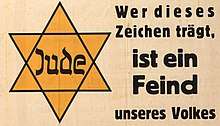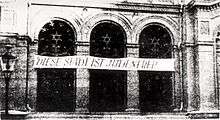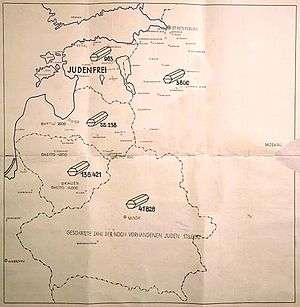Judenfrei
Judenfrei (German: [ˈjuːdn̩ˌfʁaɪ], "free of Jews") and judenrein (German: [ˈjuːdn̩ˌʁaɪn], "clean of Jews") are terms of Nazi origin to designate an area that has been "cleansed" of Jews during The Holocaust.[1] While judenfrei refers merely to "freeing" an area of all of its Jewish inhabitants, the term judenrein (literally "clean of Jews") has the stronger connotation that any trace of Jewish blood had been removed as an alleged impurity in the minds of the criminal perpetrators.[2] These terms of racial discrimination and racial abuse are intrinsic to Nazi anti-Semitism and were used by the Nazis in Germany before World War II and in occupied countries such as Poland in 1939. Judenfrei describes the local Jewish population having been removed from a town, region, or country by forced evacuation during the Holocaust, though many Jews were hidden by local people. Removal methods included forced re-housing in Nazi ghettos especially in eastern Europe, and forced removal or Resettlement to the East by German troops, often to their deaths. Most Jews were identified from late 1941 by the Yellow badge as a result of pressure from Joseph Goebbels and Heinrich Himmler.



Following the defeat of Germany in 1945, some attempts have been made to attract Jewish people back to Germany, as well as reconstruct synagogues destroyed during and after Kristallnacht. The terms judenrein and judenfrei have since been used in the persecution of global Jewish communities or the nation of Israel.
Locations declared judenfrei
Establishments, villages, cities, and regions were declared judenfrei or judenrein after they were apparently cleared of Jews. However some Jewish people survived by being hidden and sheltered by friendly neighbours. In Berlin, they were known as "submariners" since they seemed to have disappeared (under the waves). Many survived the end of the war and were Holocaust survivors.
- Gelnhausen, Germany – reported judenfrei on November 1, 1938, by propaganda newspaper Kinzigwacht after its synagogue was closed and remaining local Jews forced to leave the town.[3]
- German-occupied Bydgoszcz (Poland) – reported judenfrei in December 1939.
- German-annexed Alsace – reported judenrein by Robert Heinrich Wagner in July 1940.[4]
- Banat, German-occupied territory of Serbia – reported judenfrei on 19 August 1941 in Völkische Beobachter (lit. People's Observer).[5] On 20 August 1941 Banat was declared judenfrei by its German administrators.[6]
- German-occupied Luxembourg – reported judenfrei by the press on October 17, 1941.[7]
- German-occupied Estonia – December 1941.[8] Reported as judenfrei at the Wannsee Conference on January 20, 1942.[9]
- Independent State of Croatia – Declared judenfrei by Interior Minister Andrija Artuković in February 1942 but in Germany suspected that this is not true and authority from Berlin sent Franz Abromeit to check situation. After that Ustashe were under pressure to finish the job. In April 1942 Jews from Osijek were deported to Jasenovac, two hundred of them while 2,800 were sent to Auschwitz.[10] Gestapo in May 1943 organized departure of last Jews from Croatia, 1,700 were from Zagreb and 2,500 from other parts of NDH which were sent to Auschwich.[11][12]:107 German diplomat Siegfried Kasche pronouncement Judenfrei in a message to Berlin on 18 April 1944, stating that "Croatia is one of the countries in which the Jewish problem has been solved".[13][14]
- German-occupied territory of Serbia / Belgrade – May 1942, reported in the SS-Standartenführer Emanuel Schäfer cable sent to the Reich Main Security Office in Berlin; Schäfer was the Der Befehlshaber der SIPO und des SD head at that time in Belgrade,[15][16][17][18] while in June 1942 he reported to his supervisors that "Serbien ist Judenfrei" (lit. "Serbia is free of Jews").[12]:3 In August 1942, Harald Turner reported to the German commander in the Balkans that Serbia was the first European territory where the "Jewish problem" was solved.[19][20]:118
- Vienna – reported judenfrei by Alois Brunner on October 9, 1942.
- Berlin, Germany – May 19, 1943.[21]
- Erlangen, Germany was declared judenfrei in 1944.
Modern usage
Israeli–Palestinian conflict
In the Israeli-Palestinian conflict, a fear among many Israelis which has been reflected by Israeli government officials such as Benjamin Netanyahu[22] is that the proposed removal of Israeli Jewish settlements in the West Bank according to the wishes of Palestinian officials is tantamount to rendering these areas judenrein, or clean of Jews.
On July 9, 2009, Benjamin Netanyahu, in a discussion with the German foreign minister Frank-Walter Steinmeier is reported to have said, using the Israeli terms of the area, "Judea and Samaria cannot be judenrein."[23]
In 1952 Pesach Lev, first mayor of Lod after it was resettled by Israelis, said that Lod was transformed from "a neglected Arab town that was judenrein to a 'Hebraic city'".
Islamic world
The depopulation of the Jewish communities from Arab and Muslim countries of the Middle East and North Africa has also been described as part of an effort to make them judenrein or judenfrei. Dr. Peter Schotten wrote on the matter, saying "Arab states responded ruthlessly to the lost war and to the newly displaced Arab refugees by undertaking systematic and bold oppressive measures against their Jewish citizens. Their citizenship was stripped, arrests and detentions took place, religious restrictions were imposed, freedom of movement was curtailed, assets were frozen and property seized, employment opportunities were closed off and Zionism was criminalized."[24] Lyn Julius wrote in the Jewish Journal, "Only three years after the end of World War II, the members of the Arab League were bent on emulating the Nazis. They set about making the Arab Middle East judenrein (free of Jews). They applied Nuremberg-style laws, criminalizing Zionism, freezing Jewish bank accounts, instituting quotas, imposing restrictions on jobs and movement. The result was the mass exodus and spoliation of a million Jews."[25] The status of former Jewish Communities of Kurdistan[26], Saudi Arabia, Jordan, Syria, Kuwait, Oman, Algeria[27][28], Libya, Sudan, Malaysia are believed to have no remaining Jewish population. In 2017, Iraq had a reported 10 Jews left; in 2020 no Jews are listed for Iraq[29]. On July 13, 2020, it was reported that the last Jews of Yemen are captives of the Houthi Militia of the Kharif District.[30] (As of July 16, 2020 there are about 33 Jews left in Yemen[31]). In 2018, 4 Jews were in Dhaka, Bangladesh [32] while Afghanistan has a single Jew, Zablon Simintov.[33]Eritrea also has single native Jewish resident Sami Cohen, who runs an import-export business and attends to the Asmara Synagogue.[34][35] Lebanon, Egypt, Iran, Qatar, Ethiopia, Djibouti, Morocco, Turkey, Tunisia, and Armenia have also seen huge declines in Jewish population.
References
- Scheffler, Wolfgang (2007). "Judenrein". Encyclopaedia Judaica (2 ed.). Thomson Gale.
- "Aryanization: Judenrein & Judenfrei". shoaheducation.com.
- "'Gelnhausen endlich judenfrei': Zur Geschichte der Juden während der Nationalsozialistischen Verfolgung" ['Gelnhausen finally free of Jews': On the History of the Jews during the Nazi persecution] (PDF) (in German). Archived from the original (PDF) on September 28, 2007.
- Blumenkranz, Bernhard; Catane, Moshe (2007). "Alsace". Encyclopaedia Judaica (2 ed.). Thomson Gale.
- Drndić, Daša (2009). April u Berlinu. Fraktura. p. 24. ISBN 978-953-266-095-1.
Njemački list Völkische Beobachter objavio je 19. kolovoza 1941. da je Banat konačno Juden frei.
- Muth, Thorsten (2009). Das Judentum: Geschichte und Kultur. Pressel. p. 452. ISBN 978-3-937950-28-0.
Am 20. August konnte die deutsche Führung das Banat für Judenfrei" erklären.
- "Commémoration de la Shoah au Luxembourg" [Commemoration of the Shoah in Luxembourg] (in French). Government of Luxembourg. July 3, 2005. Archived from the original on September 30, 2007.
- "Extract from Report by Einsatzgruppe A". Archived from the original on November 12, 2007. Partial Translation of Document 2273-PS Source: Nazi Conspiracy and Aggression, Vol. IV. USGPO, Washington, 1946, pp. 944–949
- "Estonian Jews". Simon Wiesenthal Center. Archived from the original on September 28, 2007. sourced to Encyclopedia of the Holocaust. New York: Macmillan Publishing Company. 1990.
- Subotić, Jelena (2019). Yellow Star, Red Star: Holocaust Remembrance after Communism. Ithaca, New York: Cornell University Press. p. 106. ISBN 978-1-50174-241-5.
- Bulajić, Milan (2002). Jasenovac: the Jewish Serbian holocaust (the role of the Vatican) in Nazi-Ustasha Croatia (1941-1945). p. 222.
- Subotić, Jelena (2019). Yellow Star, Red Star: Holocaust Remembrance after Communism.
- Jewish History of Yugoslavia, porges.net; accessed 5 May 2016.
- "Povijest Židova Jugoslavije" (in French). Porges.net. Retrieved August 12, 2015.
- Lituchy, Barry M. Jasenovac and the Holocaust in Yugoslavia: analyses and survivor testimonies. Jasenovac Research Institute. pp. xxxiii. ISBN 978-0-97534-320-3.
- Manoschek, Walter (1995). "Serbien ist judenfrei": militärische Besatzungspolitik und Judenvernichtung in Serbien 1941/42. Walter de Gruyter. p. 184. ISBN 9783486561371.
- Lebel, G'eni (2007). Until "the Final Solution": The Jews in Belgrade 1521 - 1942. Avotaynu. p. 329. ISBN 9781886223332.
- Herbert, Ulrich; Schildt, Axel (1998). Kriegsende in Europa. Klartext. p. 149. ISBN 9783884745113.
- John K. Cox; (2002) The History of Serbia p. 92-93; Greenwood, ISBN 0313312907
- Prusin, Alexander (2017). Serbia Under the Swastika: A World War II Occupation. Urbana, Illinois: University of Illinois Press. ISBN 978-0-252-09961-8.
- "Was war am 19. Mai 1943" [What was on May 19, 1943] (in German). chroniknet.
- Dan Williams (July 9, 2009). "Judenrein! Israel adopts Nazi term to back settlers". Reuters.
- "German FM: Settlements Remain Obstacle to Peace; Frank-Walter Steinmeier says is encouraged by Israel's acceptance of a two-state solution". Haaretz. Reuters and DPA. July 9, 2009.
- "The Great Escape: How and Why Most Arab States Became Judenfrei - jewishideas.org". www.jewishideas.org.
- says, Carol denbo (February 8, 2018). "Arab anti-Semitism, and the Nazis".
- In 2015 according to the Kurdistan Jews in Israel there were no Jews remaining in the Kurdistan Region. See "Dismissal of Jewish representative 'administrative,' unrelated to Baghdad: KRG"."Publicity seeking Kurdish official brings back memories of Jewish Kurd aliya fiasco".
- "Home, for Algeria's Jews, is elsewhere". OpenGlobalRights.
- Jewish Population by Country 2020 None listed in Algeria
- Jewish Population by Country 2020 None listed in Iraq
- Baltimore Jewish News July 13,2020
- Houthis (Arianize) Arabianize Jewish property in Yemen and force Jews to flee July 24,2020
- [But despite this history, today, the Jewish population of Bangladesh is virtually non-existent. According to local sources, there are only 4 Jews living in Dhaka and they keep their identity private.What happened to the Jews of Bangladesh? - Foreign Policy ...foreignpolicyblogs.com/2018/04/30/what-happened-to-th]
- "Jewish Refugees from Arab Countries". www.jewishvirtuallibrary.org.
- "Asmara's last Jew recalls 'good old days'". BBC News. April 30, 2006. Retrieved September 26, 2006.
- "Eritrea's last native Jew tends graves, remembers". Reuters. May 2, 2006. Retrieved September 26, 2006.
